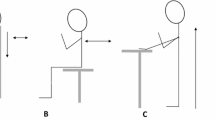Abstract
The present study involves a replication and extension of previous research examining distance fading to decrease inappropriate mealtime behavior and increase liquid consumption from a cup. The presentation of a cup of water was associated with high levels of inappropriate behavior and low levels of consumption. A cup distance fading procedure was used to systematically expose the participant to a cup of water that initially resulted in high levels of inappropriate mealtime behavior and no consumption. Inappropriate mealtime behavior decreased and consumption increased during the distance fading intervention. Implications for future research and practice are provided.

Similar content being viewed by others
References
Bachmeyer, M. B. (2009). Treatment of selective and inadequate food intake in children: a review and practical guide. Behavior Analysis in Practice, 2, 43–50.
Bachmeyer, M. B., Piazza, C. C., Frederick, L. D., Reed, G. K., Rivas, K. D., & Kadey, H. J. (2009). Functional analysis and treatment of multiply controlled inappropriate mealtime behavior. Journal of Applied Behavior Analysis, 42, 641–658.
Lerman, D. C., Iwata, B. A., & Wallace, M. D. (1999). Side effects of extinction: prevalence of bursting and aggression during the treatment of self-injurious behavior. Journal of Applied Behavior Analysis, 32, 1–8.
Najdowski, A. C., Wallace, M. D., Penrod, B., Tarbox, J., Reagon, K., & Higbee, T. S. (2008). Caregiver conducted experimental functional analyses of inappropriate mealtime behavior. Journal of Applied Behavior Analysis, 41, 459–465.
Patel, M. R., Piazza, C. C., Kelly, M. L., Ochsner, C. A., & Santana, C. M. (2001). Using a fading procedure to increase fluid consumption in a child with feeding problems. Journal of Applied Behavior Analysis, 34, 357–360.
Piazza, C. C. (2008). Feeding disorders and behavior: what have we learned? Developmental Disabilities Research Reviews, 14, 174–181.
Piazza, C. C., Fisher, W. W., Brown, K. A., Shore, B. A., Patel, M. R., Katz, R. M., et al. (2003). Functional analysis of inappropriate mealtime behaviors. Journal of Applied Behavior Analysis, 36, 187–204.
Reed, G. K., Piazza, C. C., Patel, M. R., Layer, S. A., Bachmeyer, M. H., Bethke, S. D., et al. (2004). On the relative contributions of noncontingent reinforcement and escape extinction in the treatment of food refusal. Journal of Applied Behavior Analysis, 37, 27–42.
Rivas, K. D., Piazza, C. C., Patel, M. R., & Bachmeyer, M. H. (2010). Spoon distance fading with and without escape extinction as treatment for food refusal. Journal of Applied Behavior Analysis, 43, 673–683.
Author information
Authors and Affiliations
Corresponding author
Rights and permissions
About this article
Cite this article
Sasaki, A.M., Fryling, M.J. Cup Distance Fading to Decrease Inappropriate Behavior in a Child with Autism. J Dev Phys Disabil 26, 507–512 (2014). https://doi.org/10.1007/s10882-013-9355-z
Published:
Issue Date:
DOI: https://doi.org/10.1007/s10882-013-9355-z




